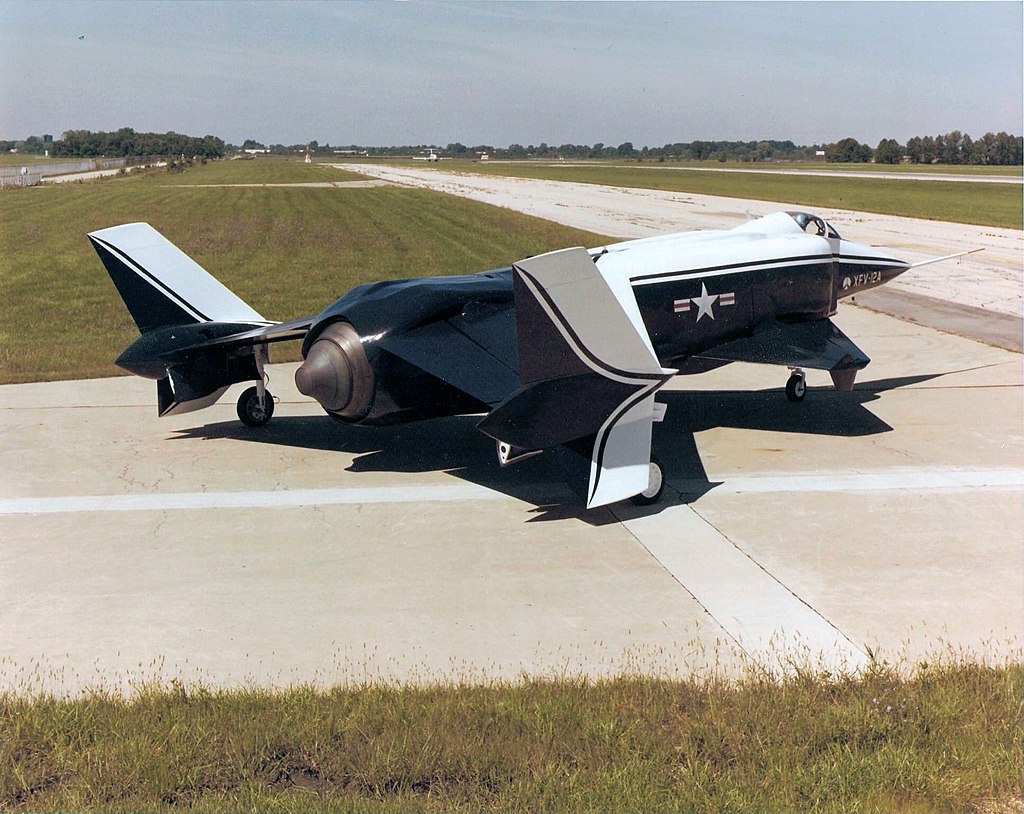The Rockwell XFV-12 was an American prototype of a supersonic carrier-based VTOL (Vertical Take-Off and Landing) fighter developed during the early 1970s for the U.S. Navy under the Vertical Fighter Attack-X program. Rockwell International, a Boeing predecessor company, submitted an entry featuring a Thrust Augmenter Wing (TAW) concept and was awarded a $47 million contract in May 1972 for two demonstrators.
The XFV-12 was certainly a futuristic-looking fighter aircraft designed to combine the Mach 2 speed and AIM-7 Sparrow armament of the McDonnell Douglas F-4 Phantom II in a VTOL fighter for the small Sea Control Ship which was an understudy at the time. It was a marriage of designs that fit well together, producing a design similar to that of the British Harrier VTOL series. One of the most characteristic design elements became the wing planform which featured a distinct rear-set mainplane assembly coupled to all-moving forward canards. The large wing was utilized fully for the „thrust augmented” concept to which thrust could be delivered through various openings found throughout the wings and canard foreplanes. Power was delivered through a single Pratt&Whitney F401-PW-400 afterburning turbofan engine. Development estimates considered the installation to provide the aircraft with enough direct lift power but the complicated internal workings of extensive ductwork eliminated much of the thrust power resulting in less-than-expected performance.

The TAW system was designed to flow ducted air into a full span ejector flap system in the wings and in the canards. With the rear exhaust nozzle closed, engine thrust was augmented by drawing air in from the top of the fuselage and into flaps (movable panels) that carried exhaust gases to augmenter exit nozzles. This would also result in a cooler exhaust footprint on the carrier deck. Once the flight was achieved, the nozzles would be rotated to transition the aircraft to conventional flight mode. Additionally, the mixing of primary and ambient air above the wings would provide increased vertical lift, thus easing the transition. To reduce costs, the nose from a Douglas A-4 Skyhawk and intakes from the F-4 was used.
Free-flight model tests conducted at the NASA Langley full-scale wind tunnel showed the projected thrust augmentation levels were highly optimistic, and that the aircraft would most likely be incapable of vertical flight on the thrust available, while the design remained suitable for conventional flight.
Ground testing of the XFV-12A began in July 1977, and the aircraft was officially rolled out at the Rockwell International facility in Columbus, Ohio on 26 August. The design lacked sufficient vertical trust. Lab tests showed 55% thrust augmentation should be expected, however, differences in the scaled-up system dropped augmentation levels to 19% for the wing and 6% for the canard. While the augmenters did work as expected, the extensive ducting of the propulsion system degraded thrust, and in the end, the power-to-weight ratio was such that the engine was capable of vertically lifting only 75% of the weight of the aircraft in which it was mounted.
The armament was to consist of a single 20mm Gatling cannon as well as a mix of air-to-air missile systems in the form of the AIM-7 Sparrow and AIM-9 Sidewinder series. Because of the nature of the VTOL internal workings, the armament positioning would be restricted to a few hardpoints – none underwing – all located along the fuselage.
With project complexity and cost overruns beginning to take their toll, the XFV-12 was canceled by the U.S. Navy. The British Hawker Siddeley remained the VTOL champion of the skies and was even adopted by the United States Marine Corps. Its replacement is the Lockheed Martin F-35 Lightning II, which uses a shaft-driven fan and a swiveling rear nozzle to achieve vertical landing. It is designed for supersonic and vertical flight with performance just over Mach 1.5 with weapons and a range comparable to the older F-4 and F-18.
Following program cancellation, the aircraft was disassembled and the cockpit section of the fuselage was stored at NASA’s Plum Brook Station in Sandusky, Ohio. As of May 2012, a group of high school students at the EHOVE Career Center, with guidance from NASA contractor personnel, were to restore the fuselage for use as a museum display.
General characteristics
- Crew: 1
- Length: 43 ft 11 in (13.39 m)
- Wingspan: 28 ft 6.25 in (8.6932 m)
- Height: 10 ft 4 in (3.15 m)
- Wing area: 293 sq ft (27.2 m2)
- Empty weight: 13,800 lb (6,260 kg)
- Gross weight: 19,500 lb (8,845 kg)
- Max takeoff weight: 24,250 lb (11,000 kg)
- Fuel capacity: 2,763 l (730 US gal; 608 imp gal) in two fuselage bladder tanks and two integral wing tanks
- Powerplant: 1 × Pratt & Whitney F401-PW-400 afterburning turbofan engine, 30,000 lbf (130 kN) with afterburner
Performance
- Maximum speed: Mach 2.2-2.4
- Thrust/weight: 1.5 (conventional)
- Take-off run: 300 ft (91 m) at 24,250 lb (11,000 kg)
Armament
- Guns: 1 20 mm M61 Vulcan cannon, 639 rounds
- Missiles: 2 AIM-7 Sparrow (carried under fuselage) and 2 AIM-9L Sidewinder AAMs or 4 AIM-7s
If you want to learn more about the Rockwell XFV-12 Fighter check out this video.
